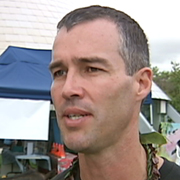HAWAII ISLAND – Actor Jason Scott Lee has lent his voice to the plight of the native palila bird, literally.
Lee’s talents are featured in a new Public Service Announcement as the voice of a talking palila, an endangered honeycreeper found exclusively in a small patch of mamane forest on Mauna Kea. The new outreach campaign was initiated by The Hawaii Department of Land and Natural Resource’s Division of Forestry and Wildlife (DOFAW) and American Bird Conservancy.
Its not the first time Lee has helped the DLNR on a video project. But this is the first time the actor, who has starred in 25 motion pictures, has portrayed a bird for the state.
The palila needs all the help it can get. The population of the critically endangered bird continues to drop.
We recently spoke to Robert Stephens, Coordinator for DLNR’s Mauna Kea Forest Restoration Project, about the palila (see our Palila Palooza story). He was also quoted in a DLNR media release promoting the new PSA.
In January 2014, the state says a 9 x 12-foot mural featuring Palila and mamane will be completed for display on a prominent building in downtown Hilo.
From the DLNR media release:
| The Palila has been loved by Hawaiians since ancient times and, along with other native species, they formed the environment that influenced the formation of a unique culture. Queen Emma visited Mauna Kea in the early 1880s, and a series of mele (chants) commemorate the event, including one describing the memorable song of Palila (from Nogelmeier 2001, He Lei no Emalani: Chants for Queen Emma Kaleleonalani).
E aha ana lâ ‘Emalani I ka wai kapu a Lilinoe E nanea, e walea a‘e ana I ka hone mai a ka palila Oia manu noho Kuahiwi The population of the Palila, a Hawaiian honeycreeper, has declined 66 percent in the past decade, with fewer than 2,200 birds currently left. The Palila’s downward population slide is a result of habitat degradation, predation, and severe drought conditions that are causing reductions in food supply. The native mamane and naio forests upon which the Palila depends have been degraded by non-native feral sheep, goats, cattle, and hybrid mouflon sheep over the past 200 years. The Palila once lived across most of the Island of Hawai‘i, but its range has shrunk to roughly 5 percent of its historical size. Other threats include long-term drought influenced by climate change, non-native, feral cats and mongooses that prey on adults and nestlings, fire, and invasive non-native plants. In a series of court orders beginning in 1979, the U.S. District Court for the District of Hawai‘i ruled that to prevent the bird’s extinction, the Department of Land and Natural Resources must permanently remove non-native ungulates (grazing mammals) from the Palila’s designated Critical Habitat on Mauna Kea through all necessary means, including fencing and aerial hunts. “The Department of Land and Natural Resources is committed to protecting and conserving Hawai‘i’s unique natural, cultural and historic resources which are held in public trust for current and future generations of the people of Hawai‘i nei. We hope our children’s children will be able to know the soothing song of the Palila,” said William Aila, DLNR Chairperson. DOFAW, with critical support from the U.S. Fish and Wildlife Service, is replacing the fence that encircles the majority of Palila critical habitat on Mauna Kea to prevent sheep and goats on adjacent lands from entering protected areas, while also removing the non-native ungulates from within the fence that destroy the native forests. In addition, DOFAW, the Mauna Kea Forest Restoration Project, ABC, and hundreds of local volunteers are restoring and replanting Mauna Kea’s mamane forest, which Palila depend upon for about 90% of their diet. “The Palila is a gorgeous, unique Hawaiian treasure, but unfortunately not enough people are aware of its precarious situation,” said Chris Farmer, American Bird Conservancy’s Science Coordinator for Hawai‘i. “We believe educating people about the importance of this species and the threats we are managing today, will build local and national support for the actions necessary to preserve this bird for future generations.” |


by Big Island Video News4:05 pm
on at
STORY SUMMARY
HAWAII ISLAND – Actor Jason Scott Lee has lent his voice to the plight of the native palila bird, literally. Lee’s talents are featured in a new Public Service Announcement as the voice of a talking palila, an endangered honeycreeper found exclusively in a small patch of mamane forest on Mauna Kea. The new outreach […]